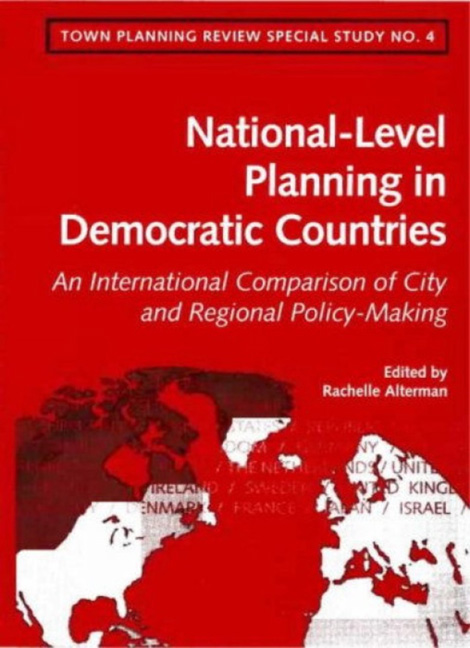 National-Level Spatial Planning in Democratic Countries
National-Level Spatial Planning in Democratic Countries Book contents
- Frontmatter
- Dedication
- Contents
- List of Figures
- List of Tables
- Preface
- About the Contributors
- 1 National-Level Planning in Democratic Countries: A Comparative Perspective
- 2 National Land-Use Planning and Regulation in the United States: Understanding its Fundamental Importance
- 3 Structures for Policy-Making and the Implementation of Planning in the Republic of Ireland
- 4 Rethinking Swedish National Planning
- 5 National-Level Institutions and Decision-Making Processes for Spatial Planning in the United Kingdom
- 6 National-Level Planning Institutions and Decisions in the Federal Republic of Germany
- 7 National-Level Planning in the Danish System
- 8 National-Level Planning Institutions and Decision-Making in France
- 9 National-Level Economic and Spatial Planning in Japan
- 10 Dutch National Planning at the Turning Point: Rethinking Institutional Arrangements
- 11 National-Level Planning in Israel: Walking the Tightrope Between Government Control and Privatisation
10 - Dutch National Planning at the Turning Point: Rethinking Institutional Arrangements
- Frontmatter
- Dedication
- Contents
- List of Figures
- List of Tables
- Preface
- About the Contributors
- 1 National-Level Planning in Democratic Countries: A Comparative Perspective
- 2 National Land-Use Planning and Regulation in the United States: Understanding its Fundamental Importance
- 3 Structures for Policy-Making and the Implementation of Planning in the Republic of Ireland
- 4 Rethinking Swedish National Planning
- 5 National-Level Institutions and Decision-Making Processes for Spatial Planning in the United Kingdom
- 6 National-Level Planning Institutions and Decisions in the Federal Republic of Germany
- 7 National-Level Planning in the Danish System
- 8 National-Level Planning Institutions and Decision-Making in France
- 9 National-Level Economic and Spatial Planning in Japan
- 10 Dutch National Planning at the Turning Point: Rethinking Institutional Arrangements
- 11 National-Level Planning in Israel: Walking the Tightrope Between Government Control and Privatisation
Summary
Introduction
The Dutch like the idea that foreigners visiting the Netherlands are more often than not impressed by the fact that the country looks tidy, clean and well organised. Needham (1989), speaks of a ‘manicured environment’. Dutch spatial planners like to think that they have contributed to that manicured environment and that they have ‘planned’ its development. But Needham warns the reader: ‘although there is massive public intervention with changing and maintaining the physical environment, and that massive public intervention indeed results in an overall good or even high quality, one would be wrong to include this under the planning system, ‘‘for it is not part of that system in the sense of statutory physical planning’’ ’ (Needham, 1989, 15). He argues that, in tandem with the virtues of orderliness and cleanliness and the egalitarianism of Dutch society, the active land policy of the municipalities and the highly effective work of executive agencies like those for water management, land consolidation, infrastructure, heritage conservation and forestry, contribute more to that ‘manicured environment’ than the planning system itself. Needham is willing to recognise that the Dutch physical environment is ‘planned’ only where he is convinced that the system has succeeded in coordinating public intervention.
With his rather paradoxical appreciation of the Dutch situation, Needham is really questioning the performance—or effectiveness—of the Dutch planning system. Its primary aim has been to secure that coordination of public intervention in the physical environment. In this paper we discuss whether or not it succeeds. We will limit ourselves to the institutional and legal-organisational arrangements that shape Dutch strategic planning at the national level and which have gained momentum since the 1950s. It is an important instrument in building the Dutch welfare state (Faludi, 1989). Here, we will examine the conditions within which the system has to work and ask whether it is functioning as it was intended.
To answer these questions, a broad outline of the context of strategic spatial planning in terms of some socio-economic statistics, the governmental system and the planning tradition will be given. This is followed by a description of the institutional setting of the planning system as it came into being in the mid-1960s. This has basically remained stable during the last three decades. The next section is devoted to how the system functioned and how it developed at the national level.
- Type
- Chapter
- Information
- National-Level Spatial Planning in Democratic CountriesAn International Comparison of City and Regional Policy-Making, pp. 219 - 256Publisher: Liverpool University PressPrint publication year: 2001


